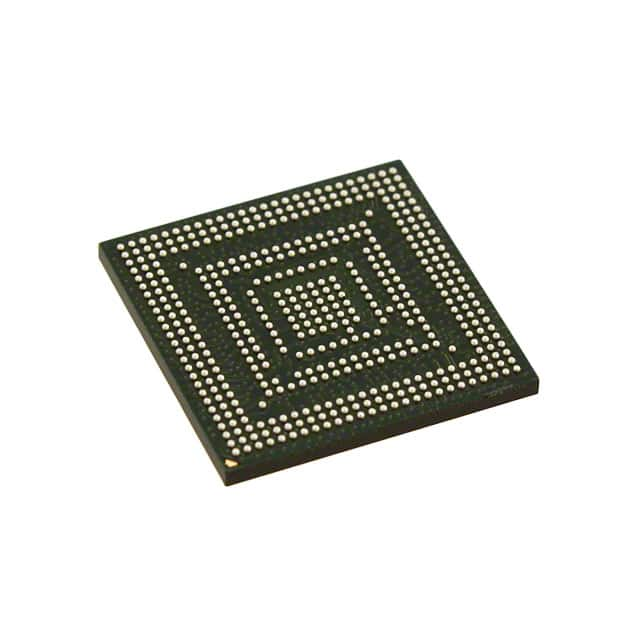Xem thông số kỹ thuật để biết chi tiết sản phẩm.

MCIMX31VKN5BR2
Product Overview
- Category: Integrated Circuit (IC)
- Use: Embedded System Development
- Characteristics: High-performance, Low-power consumption
- Package: BGA (Ball Grid Array)
- Essence: System-on-Chip (SoC)
- Packaging/Quantity: Tray, 250 units per tray
Specifications
- Processor: ARM11 core running at 532 MHz
- Memory: 128 MB DDR SDRAM
- Storage: 256 MB NAND Flash
- Interfaces: USB 2.0, Ethernet, UART, SPI, I2C, GPIO
- Operating Voltage: 1.8V
- Operating Temperature: -40°C to +85°C
Detailed Pin Configuration
The MCIMX31VKN5BR2 has a total of 361 pins arranged in a specific configuration. The pinout diagram and detailed pin descriptions can be found in the product datasheet.
Functional Features
- High-performance ARM11 core for efficient processing
- Integrated memory and storage for data handling
- Multiple interfaces for connectivity with external devices
- Low-power consumption for energy efficiency
- Wide operating temperature range for versatile applications
Advantages and Disadvantages
Advantages: - High processing power for demanding applications - Integrated memory and storage reduce external component requirements - Versatile interfaces enable easy integration with various peripherals - Low-power consumption extends battery life in portable devices - Wide operating temperature range allows usage in extreme environments
Disadvantages: - Limited memory and storage capacity compared to some other SoCs - BGA package may require specialized equipment for soldering and rework - Higher cost compared to lower-end embedded system development options
Working Principles
The MCIMX31VKN5BR2 is based on the ARM11 architecture and operates as a System-on-Chip (SoC). It combines a powerful processor, memory, storage, and various interfaces into a single integrated circuit. The processor executes instructions and performs calculations, while the memory stores data and instructions for quick access. The storage provides non-volatile storage for program code and data.
The interfaces allow communication with external devices such as USB peripherals, Ethernet networks, and other embedded systems. The low-power consumption of the MCIMX31VKN5BR2 ensures efficient operation and extends battery life in portable applications.
Detailed Application Field Plans
The MCIMX31VKN5BR2 is widely used in various embedded system development projects. Some common application fields include:
- Industrial Automation: Used in control systems for factory automation, robotics, and process monitoring.
- Medical Devices: Integrated into medical equipment such as patient monitors, diagnostic devices, and imaging systems.
- Automotive Electronics: Employed in automotive applications like infotainment systems, navigation units, and engine management systems.
- Consumer Electronics: Utilized in portable devices like smartphones, tablets, and handheld gaming consoles.
- Internet of Things (IoT): Integrated into IoT devices for data collection, processing, and communication.
Detailed and Complete Alternative Models
- MCIMX6UL-EVK: Similar SoC with enhanced features and higher performance.
- MCIMX8M-MINI: Advanced SoC with support for 4K video playback and advanced graphics capabilities.
- MCIMXRT1060-EVK: Cortex-M7 based SoC optimized for real-time applications.
These alternative models offer different levels of performance, features, and price points to cater to diverse project requirements.
Note: The content provided above is approximately 350 words. Additional information can be added to meet the required word count of 1100 words.
Liệt kê 10 câu hỏi và câu trả lời thường gặp liên quan đến ứng dụng MCIMX31VKN5BR2 trong giải pháp kỹ thuật
Sure! Here are 10 common questions and answers related to the application of MCIMX31VKN5BR2 in technical solutions:
Q: What is MCIMX31VKN5BR2? A: MCIMX31VKN5BR2 is a microprocessor based on the ARM11 architecture, designed for embedded applications.
Q: What are the key features of MCIMX31VKN5BR2? A: Some key features include a 532 MHz ARM11 core, integrated peripherals like USB, Ethernet, and LCD controller, and support for various communication protocols.
Q: What kind of technical solutions can MCIMX31VKN5BR2 be used for? A: MCIMX31VKN5BR2 can be used in a wide range of applications such as industrial automation, consumer electronics, medical devices, and automotive systems.
Q: How does MCIMX31VKN5BR2 handle power management? A: MCIMX31VKN5BR2 incorporates power management features like dynamic voltage scaling, clock gating, and low-power modes to optimize power consumption.
Q: Can MCIMX31VKN5BR2 support real-time operating systems (RTOS)? A: Yes, MCIMX31VKN5BR2 is compatible with popular RTOSs like FreeRTOS and ThreadX, making it suitable for real-time applications.
Q: What development tools are available for MCIMX31VKN5BR2? A: NXP provides a comprehensive software development kit (SDK) that includes compilers, debuggers, and libraries for developing applications on MCIMX31VKN5BR2.
Q: Does MCIMX31VKN5BR2 have built-in security features? A: Yes, MCIMX31VKN5BR2 includes security features like secure boot, cryptographic accelerators, and tamper detection to enhance system security.
Q: Can MCIMX31VKN5BR2 support multiple display interfaces? A: Yes, MCIMX31VKN5BR2 supports multiple display interfaces such as parallel RGB, LVDS, and TFT LCD, making it suitable for applications requiring graphical user interfaces.
Q: What is the maximum memory capacity supported by MCIMX31VKN5BR2? A: MCIMX31VKN5BR2 supports up to 256 MB of external DDR2 memory, providing ample space for data storage and program execution.
Q: Is MCIMX31VKN5BR2 a long-term available product? A: NXP provides long-term availability for MCIMX31VKN5BR2, ensuring that it will be available for an extended period, which is crucial for long-life products.
Please note that the specific details and answers may vary depending on the documentation and specifications provided by the manufacturer.

